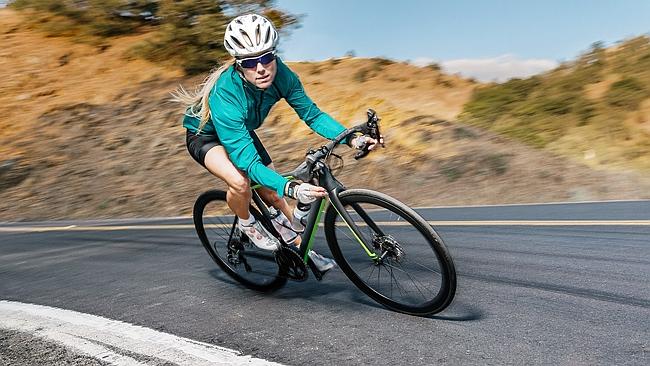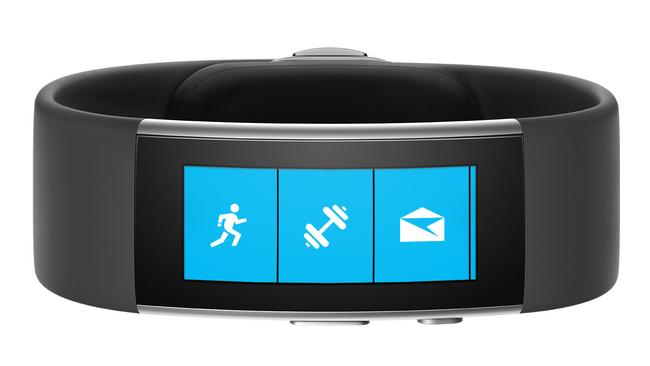Is Microsoft’s smartwatch and fitness tracker any good? We put the Band 2 through its paces
Did Microsoft just outpace Fitbit in the fitness-tracking market? Its new wearable ‘smartband’ offers more sensors but may not be as accurate.

THE hardware behind this software giant’s wearable technology is groundbreaking.
Microsoft is betting big on its Band 2, combining high-end fitness sensors with phone alerts to soothe the strongest case of FOMO.
On paper, it’s the perfect combination of smartwatch and fitness tracker.
But can Microsoft’s Band really compete with market leader Fitbit? We pitted the two against one another to find out.
FITNESS COMPETITION: Microsoft’s Band 2 eyes off Apple, Fitbit
RACE TO THE TOP: Lots of unexpected fitness technology unveiled at CES 2016
Microsoft’s Band 2 is solidly made, with metal accents, a comfortable rubber strap, and a unique metal clasp that slides and clips into position to ensure your wrist isn’t crushed.
Its 3.2cm long AMOLED touchscreen can be worn as a traditional watch or, in a mode we found easier to read, on the inside of the wrist.

Users control the Band 2 with two buttons and a touchscreen, scrolling to the right to see app shortcuts.
These shortcuts can be customised with a companion app that — in something of a coup — is available for Apple iPhones, Google Android handsets, and Windows Phones.
The Band delivers notifications from all three types of smartphone, including the basics like phone calls and text messages, but also emails, Facebook mentions, tweets, and calendar alerts.
Only basic information appears on screen, and it cannot open a phone app remotely, but these alerts do keep users in the loop enough to replace a smartwatch.
Microsoft insists the Band 2 is a fitness device first, however, and it’s easy to see why. This device has 11 sensors in total, including some its competitors do not match.
There’s a gyrometer and three-axis accelerometer for counting steps, of course, as well as an optical heart-rate sensor, a barometer to measure incline, and an ambient light sensor to adjust screen brightness.
But the Band 2 takes a few steps further. It has a GPS chip to accurately plot distance travelled, a skin temperature sensor to measure exertion, a UV sensor to tell you when to put on sunscreen, and it records the user’s galvanic skin response as an indicator of stress.
Unfortunately, the stress measurement isn’t available as a breakout reading yet, instead informing other features like sleep-tracking.

The Band uses these sensors to track not just your sleep and your every step, but your distance travelled, calories burnt, floors climbed, and to rate individual exercises such as yoga, weightlifting, and rowing.
It also offers guided workouts, delivering instructions to your wrist and cutting out the need to have a phone with you.
In fitness tests, we pitted the Band 2 against a Fitbit Charge HR, comparing heart rate, step counts, and sleep recordings.
On heart rate, the two bands were often identical. Microsoft’s Band perhaps has an advantage here as the green light it emits to measure the wearer’s pulse is better hidden and doesn’t shine in the dark.
Microsoft’s device also takes the lead on sleep tracking. While the Fitbit is better at tracking when you nod off, Microsoft offers more detail about your sleep quality, including how much time you spent in light and restful sleep, and it delivers a sleep efficiency score.
Where Microsoft’s fitness tracker falls down is in the most basic fitness measure: the step count.
The Band 2 often failed to count steps around the home, and regularly underestimated staircases climbed. At the end of a day’s testing, there was often a gulf of 1000 steps or more between its estimation and Fitbit’s tally.
Interestingly, it was accurate when on exercise equipment or when hiking outdoors, but failed indoors. The Band doesn’t seem to be quite sensitive enough to register everyday activity.
If you can overlook this frustration, Microsoft’s wearable technology is an overachiever in other ways. It’s worth noting that its battery will last for two days if you leave its watch face off, and it’s also water-resistant.
Those who want a gadget to track everyday activity might find its main failing hard to overlook, but fitness fans who want to combine GPS tracking with smartwatch features may appreciate the Band’s approach.
Microsoft Band 2
$380 / microsoftstore.com
3.5/5 stars



